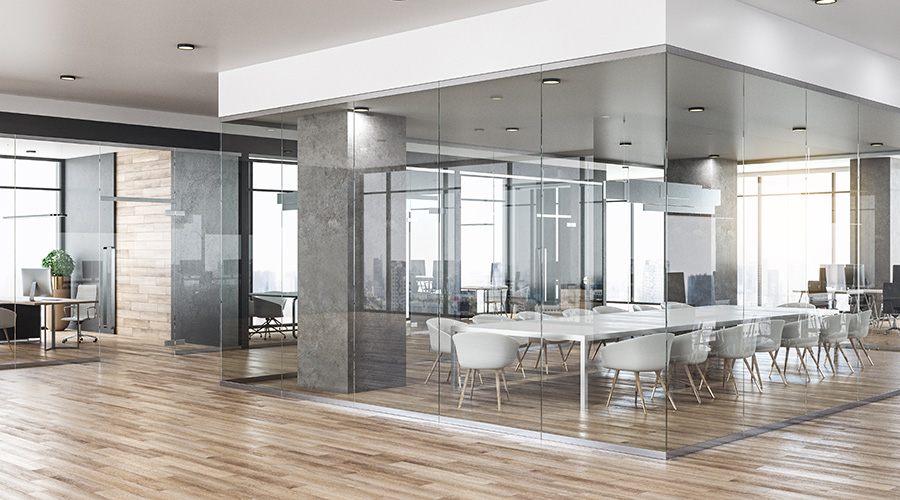Flooring Trends for Facilities with Heavy Traffic

Facility managers are seeking more durable, maintenance-free options for their buildings
Institutional and commercial facilities each have different needs for the flooring in their buildings, but all have one thing in common: Their floors experience heavy use and need to be durable to withstand the traffic.
In 2024, designers leaned into flooring trends that focused on waterproof and recycled materials, particularly with carpeting solutions, giving facility managers plenty of options for their buildings. Manufacturers are also creating materials that are easier to recycle or repurpose at the end of their life cycle, contributing to a circular economy in building design.
“We’ve also seen an increase in flooring products made in the United States, which allows for more eco-friendly transport and faster turnaround for product delivery,” says Lynae Schoen, associate at WoldArchitects and Engineers.
Facility needs
Of course, flooring trends in each building type can differ based on budget and funding available for replacement cycles. According to Schoen, in high-traffic environments like schools, healthcare and government buildings, durable and resilient flooring options are increasingly popular. Additionally, flooring materials that contribute to noise reduction are particularly important in schools and healthcare facilities. Carpet tiles are often used in educational settings, while rubber and vinyl are seen in healthcare to minimize noise transmission.
“For individual facility trends, schools tend to use a blend of flooring types that support function. Areas with high circulation and traffic typically use easy-to-clean hard surfaces with materials like terrazzo, rubber sheet goods or luxury vinyl tile (LVT) flooring,” Schoen says.
Materials used in classroom flooring can depend on the anticipated use of the room, with rooms that may feature the use of water tending to be a mix of hard surface solutions, while carpet would be used for rooms intended for quieter acoustics or play and learning activities on the floor.
Riley Zollars, senior designer at DesignGroup, has continued to see facilities gravitate toward using hard surface flooring. Many of DesignGroup’s clients are greatly limiting the use of carpet. Across the board, institutional facilities see this as a way to simplify and improve their cleaning programs. Also, with the rise in products designed to control acoustics, there is a little less pressure on flooring to fulfill that role.
“We are also seeing manufacturers push their portfolios to provide products that can work together to reduce floor transitions,” Zollars says. “Being able to design spaces with minimal changes in flooring thicknesses improves accessibility for those with vision and coordination loss, reduces edges for failure, and eliminates the need for transition accessories.”
Education designers may also consider how to use flooring as a teaching tool. Using an array of colors for recognition, custom designs for counting or designating a particular center or focus area can help support teachers in leveraging an additional surface for learning.
“We are seeing more clients across the board asking smart questions around sustainability and health and wellness impacts from the materials we use within interior spaces,” says ElizabethVon Lehe, design director at HDR. “Whether a flooring product can be part of a building’s certification has been a more important factor within the final product that gets specified, even if the building doesn’t go after certification in the end.”
Debra Kolesar, senior associate and interior designer at Moody Nolan, says that 5mm looselay LVT is making a notable rise in schools and other commercial facilities. This thicker product makes installation quicker without the use of adhesives which also makes repair or replacement much easier. It helps with the sound transmission from floor to floor, improving the acoustics of a learning environment.
“LVT is also a low maintenance resilient flooring that does not need to be waxed which is another reason for its growing popularity among facility/operation managers,” Kolesar says.
Continuous evolution
Historically, facility managers faced long replacement cycles of flooring, as large areas would have to be replaced at a time, and color matching was difficult. In the last 25 years, however, the flooring industry has made great strides in transitioning from large rolls or sheet goods to modular products.
“Modular products allow for easy replacement in the event of spills or damage, simpler storage solutions for attic stock and an efficient, budget-friendly way of staying on top of flooring replacements,” Schoen says.
Von Lehe adds that one of the most contentious flooring topics has been the use of vinyl, due to the increasing awareness of its negative environmental and health impacts.
“Even so, vinyl is still the go-to for certain markets such as healthcare, where there is zero tolerance for product failure,” Von Lehe says. “There have been huge improvements in non-PVC alternatives that can even be used within a healthcare setting – but the push to switch away from vinyl is ongoing.”
Kolesar adds that flooring manufacturers are taking steps forward to developing more sustainable products and manufacturing practices – something consumers are demanding more of. One significant advancement is PVC (polyvinyl chloride)-free flooring.
“PVC is a toxic chemical that can be harmful during production, use, and disposal so should be avoided when possible,” Kolesar says. “PVC-free flooring promotes better indoor air quality, health and environmental impacts.”
And improvements in printing capabilities are staggering. As Zollars explains, the use of visual textures adds to a designer’s toolbox and lends well to the concern of actual cleanability and visibility of scuffs and grime.
“We have seen the emergence of ‘hybrid’ flooring types; non-fibrous woven tiles, and textile composite flooring that are high performance, low maintenance and easily cleaned,” Zollars says. “These provide the soft appearance and underfoot feel while checking many performance boxes.”
Maura Keller is a freelance writer based in Plymouth, Minnesota.
Related Topics:
The post "Flooring Trends for Facilities with Heavy Traffic" appeared first on Building Operating & Management

